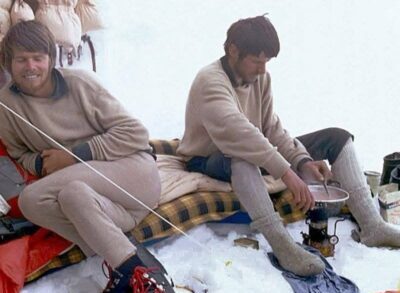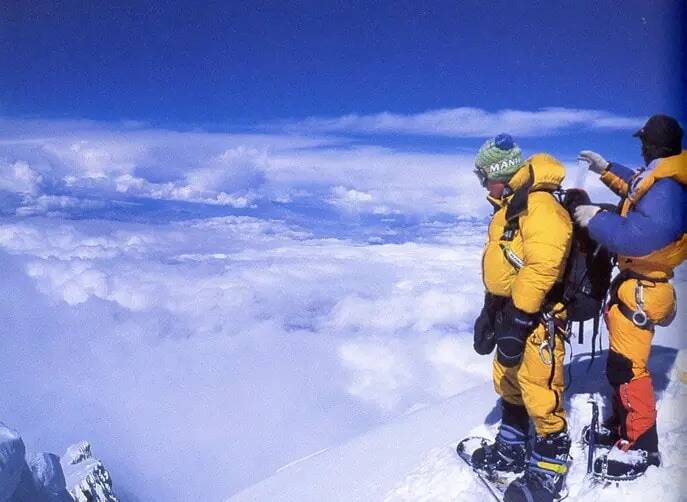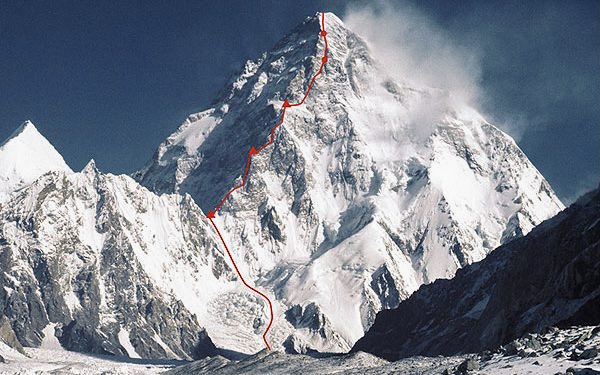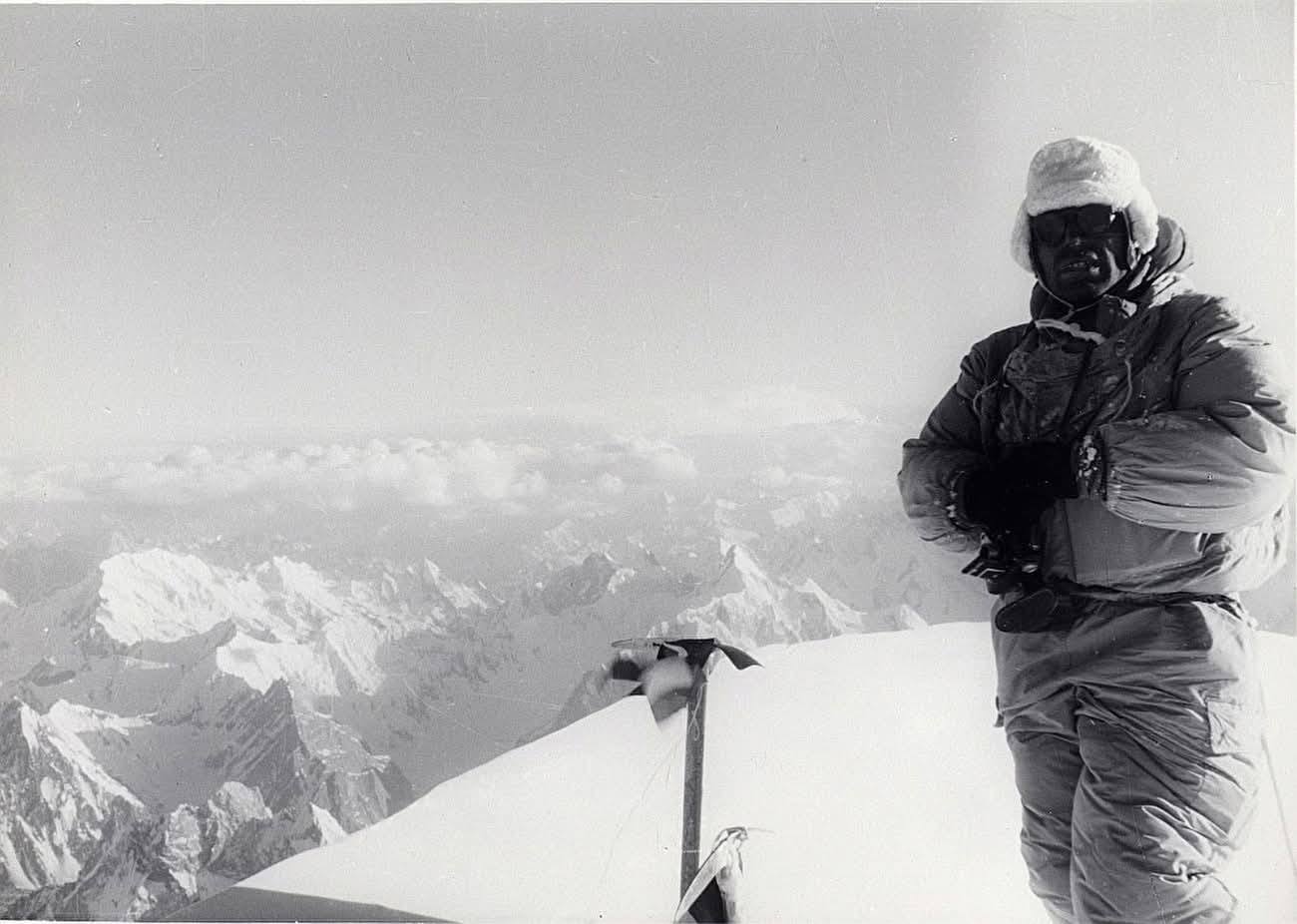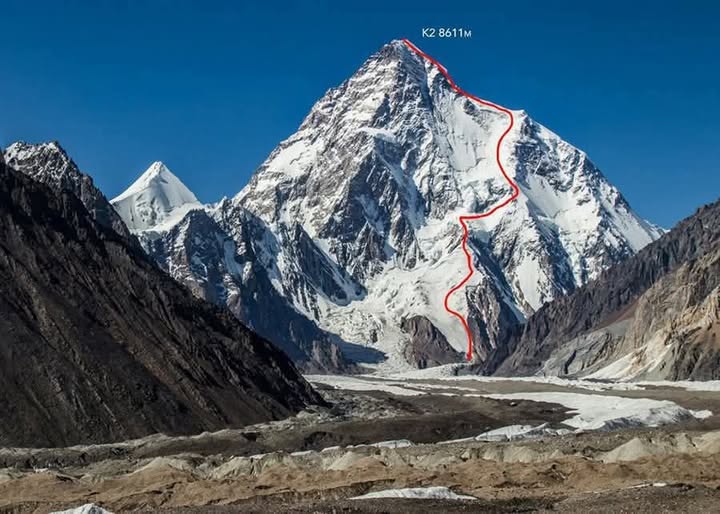In the summer of 1970, beneath the vast, glaciated walls of Nanga Parbat, two brothers stood together, facing the void. A mountain standing 8,126 meters above sea level, towering, terrifying, and unfinished.
Reinhold and Günther Messner, sons of the South Tyrolean Alps, forged in shared ambition. together. Wild, stubborn, and inseparable. Reinhold was already a legend in the making, bold, intense, relentless. Günther, quieter but no less determined, followed not in his shadow, but beside him, step for step.
Their goal: the Rupal Face. The highest mountain wall on Earth. Over 4,600 meters of vertical ice, snow, and stone. A face that had never been climbed. That was Reinhold’s obsession. That became their destiny.
They were part of a large German-Austrian expedition, led by Karl Herrligkoffer, a man possessed by Nanga Parbat ever since his half-brother Willi Merkl had perished on the mountain in 1934 with eight others. Herrligkoffer had launched six expeditions before 1970. This was to be the seventh.
At Camp 5, high on the Rupal Face, the Messners and their teammate Gerhard Baur waited for a weather signal from Base Camp. Blue rocket meant go. Red meant retreat. Radio Peshawar predicted good weather. But when Herrligkoffer fired the signal, it exploded red.
Confusion reigned. Reinhold, impatient and convinced the opportunity would slip, made a decision.
He would go alone.
Just after 2:00 a.m. on June 26, 1970, with no tent, no oxygen, and no rope partner, Reinhold started his summit bid into the dark. He struggled up the Merkl Couloir by headlamp, the steep gully carved into the face like a scar. Behind him, Günther and Baur slept.
At sunrise, Reinhold broke into open snowfields. Unknown to him, back at Camp 5, Günther awoke and made a fateful, impulsive decision. Dumping the ropes himself and Baur were fixing, he sprinted into the couloir after his brother.
Reinhold, startled, looked back to see a figure gaining, then realized it was Günther.
By late afternoon, the brothers stood together on the summit of Nanga Parbat. June 27, 1970. Together. They had done what no one had done before: climbed the Rupal Face to the top of the “Killer Mountain.”
But the summit was only halfway.
They were out of time, out of energy, and out of margin. They made an emergency bivouac high on the ridge, near the Merkl Notch, huddled under space blankets. No tent. No food. No stove. They had stepped into the death zone and stayed.
By morning, Günther was faltering. Delirious. He mumbled, staggered. Frostbite was setting in. Descent back down the Rupal Face, with its ice walls and cornices, was impossible.
So, they made a desperate decision: to descend the unknown Diamir Face on the mountain’s western side.
It was not a planned traverse. It was a plea for survival.
From Reinhold’s account, Günther had suggested the change. But Günther’s judgment, by then, was clouded by exhaustion and altitude sickness.
The descent turned into a nightmare.
They spent a second night bivouacked on the mountain, this time on the Mummery Rib exposed, freezing, at the limit of human endurance.
The next day, the brothers continued downward.
By the third day, Günther could barely walk. Reinhold moved ahead, searching for a route. Avalanches echoed constantly across the face.
And then in the chaos of the white void, Günther disappeared.
Swallowed by an ice avalanche, lost to the mountain.
Reinhold searched. He screamed into the wind. But his brother was gone.
He staggered downward, disoriented, hallucinating. Then he finally stumbled into a shepherd’s hut in the Diamir Valley. Starving. Frostbitten. Alone.
He had done what no one had done before: traversed Nanga Parbat from the Rupal to the Diamir Face. But the cost was unbearable.
And then came the doubt.
Back at Base Camp, the expedition had already begun to fracture. Word of Günther’s death spread. But so did accusations.
Some teammates claimed Reinhold had gone rogue, ignored orders, and chased glory. Max von Kienlin and Hans Saler accused him of abandoning Günther. Others suggested the descent down the Diamir Face had been premeditated, a risky move, Reinhold had spoken of even before the summit.
Herrligkoffer fanned the controversy. The narrative became murky, bitter. Lawsuits followed. Books were written. A note allegedly written by Reinhold in Gilgit surfaced, where he said, “I lost Günther. I don’t know why, but he couldn’t hear me. He didn’t make it. Maybe he fell.”
For decades, Reinhold fought not just for recognition but for truth. He scoured the Diamir Face in search of evidence. In 2000, climber Hanspeter Eisendle found a human fibula at the base of the face. DNA tests were inconclusive.
Then, in July 2005, three Pakistani locals found something more: a leather boot entombing a wool-socked foot. Nearby, they uncovered clothing and, ultimately, bones.
Reinhold recognized the gear instantly.
It was Günther.
A second boot was found in 2022, further confirming the site of the death: the lower Diamir Face, just as Reinhold had always claimed.
The remains were cremated at the foot of Nanga Parbat on September 8, 2005. In the Tibetan tradition, Reinhold and his team built a chorten, an altar of stones, for his brother. They sang to the gods and scattered rice into the air.
Yelo Lak. The gods were merciful.
But the mountain had already spoken.
In life, Günther’s story was buried beneath debate. In death, the mountain gave it back.
Reinhold would go on to become the most famous mountaineer in history. The first to climb all fourteen 8,000-meter peaks. The first to summit Everest without oxygen. The first solo ascent of Everest. The first to cross Antarctica and Greenland without mechanized support.
But Nanga Parbat never left him.
It gave him his myth. And it took his brother.
What happened on that mountain, who said what, who decided what, remains ambiguous. Even now, decades later, some doubts linger in the minds of skeptics. But the mountain remembers. It always does.
This was not just a story of a summit. Or a tragedy.
It was a story of blood and obsession, of loyalty and fracture. Of what it means to chase the impossible and what it costs to return.
For Reinhold, it was not only about reaching the top.
It was about surviving the descent and the years that followed.
Years spent answering for a choice he didn’t want to make. Years spent searching for a brother he would never again find except in bones and shadows.
Two brothers stood atop Nanga Parbat.
Only one came down.
But both are part of its story.
One forever beneath the snow.
The other, haunted yet undefeated, above the clouds.


